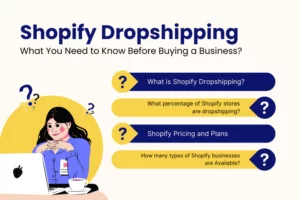So, you’ve decided to start a Shopify dropshipping store. Congratulations! It’s time to create a solid Shopify dropshipping business plan to set yourself up for success in this highly competitive industry.
In this blog, we’ll discuss the vital components of a Shopify dropshipping business plan, highlighting its role as a roadmap for e-commerce success. We’ll cover key elements from market analysis to financial projections and risk management. Plus, we’ll stress the need to update this plan for an ever-evolving online retail landscape regularly. Join us on this journey to effective Shopify dropshipping planning.
What is a Shopify Dropshipping Business Plan?

A Shopify dropshipping business plan is a detailed document that outlines the essential aspects of your business. It includes information about your target market, product offerings, marketing strategies, financial projections, etc. The plan is a comprehensive guide to help understand dropshipping challenges and opportunities. By having a well-crafted plan, you can be better prepared to navigate your business to success.
Parts of a Shopify Dropshipping Business Plan
To create a solid business plan for your Shopify dropshipping store, here are some key sections that you should include:
- Executive Summary: Give a brief, clear description of your company, outlining your mission statement, your objectives, and how you intend to get there.
- Market Analysis: Identify your target market, analyze your competition, and understand the trends and demands of the dropshipping industry.
- Product Selection and Sourcing: Determine the types of products you will be selling and conduct thorough research to ensure there is a demand for those products.
- Competitive Analysis: Analyze your competitors in the dropshipping market to understand their strategies, strengths, weaknesses, and opportunities for differentiation.
- Marketing and Advertising Strategies: Outline your marketing and advertising strategies, including social media marketing, influencer collaborations, and email marketing campaigns.
- Operations and Logistics: Explain how you will handle order fulfillment, inventory management, and customer service.
- Financial Planning: Develop a detailed financial forecast, including your revenue projections, expenses, and profitability analysis.
- Performance Monitoring and Analytics: Utilize analytics tools and set KPIs to optimize store performance and decisions.
- Risk Management and Contingency Plan: Identify potential risks your business may face and develop contingency measures to mitigate their impact, ensuring your Shop[ify store’s resilience and adaptability.
Executive Summary

Creating a solid business plan is essential for aspiring entrepreneurs looking to start a successful dropshipping business on Shopify. A well-thought-out strategy will help guide your decision-making process, identify potential challenges, and outline your goals for success.
Overview of your Shopify dropshipping business
- Clear Business Model Definition: Define your Shopify dropshipping store’s business model, which involves partnering with suppliers to handle inventory and shipping while focusing on marketing and customer inquiries.
- Detailed Product Description: In your business plan, describe the products or niche you intend to concentrate on, emphasizing market demand and competition research to identify differentiation opportunities.
- Product Quality and Price Point: Consider key factors such as product quality and price point as essential elements for setting your store apart from competitors.
- Market Differentiation Strategy: Develop a strategy to differentiate your store by leveraging factors like shipping times, offering unique products, and addressing customer needs, ensuring a strong competitive edge in the market.
Market Analysis

Creating a solid business plan is crucial for entrepreneurs diving into Shopify dropshipping. One of the critical components of a successful business plan is conducting a thorough market analysis. By understanding the current market trends and demands and identifying your target audience and their needs, you can position your dropshipping store for success.
Understanding the current market trends and demands
- Identify market trends: Research current market trends, such as emerging product categories or consumer behaviors, to ensure you offer products in demand.
- Conduct competitor analysis: Analyze your competition to understand what products are performing well in your niche, helping you make informed product selections that will likely succeed in the market.
- Analyze customers: Identify consumer preferences to ensure your product offerings align with market demand, ultimately increasing the likelihood of sales and customer satisfaction.
Identifying your target audience and their needs
- Know your audience: Creating highly targeted marketing campaigns requires defining a specific audience based on age, gender, location, and interests.
- Collect demographic data: Research the demographic characteristics, such as income levels, education, and lifestyle, to tailor your product offerings and pricing accordingly.
- Identify pain points: Understand their pain points and challenges to offer solutions through your products, addressing their needs directly.
- Personalize product choices: Tailor your product selection to match customer preferences to increase conversions.
By conducting a thorough market analysis and understanding the current market trends and demands, as well as the needs of your target audience, you can create a solid business plan for your Shopify dropshipping store. This plan will serve as a roadmap for success and help you make informed decisions to grow your business.
Product Selection and Sourcing

For aspiring entrepreneurs looking to start a Shopify dropshipping store, one of the critical elements to success lies in choosing the right products and establishing reliable supplier partnerships.
Choosing profitable products for your dropshipping store
- Identify a niche: Choose a niche aligned with your passion, expertise, and market demand. Focusing on a specific niche helps you target a more specific audience and can increase your chances of success.
- Conduct market research: Analyze market trends, competition, and customer preferences to identify profitable products within your chosen niche. Look for products with high demand and low competition to maximize your chances of generating sales.
- Consider product viability: Evaluate factors such as product quality, shipping time, and potential for profit margins. Choose products that can be easily shipped, have a reasonable price point, and offer good profit margins for your business.
Finding reliable suppliers and establishing partnerships
- Research and vet suppliers: Look for providers with a good reputation who provide high-caliber goods at reasonable prices with dependable shipping. To make sure they fulfill your criteria, read product reviews, evaluate costs, and ask for product samples.
- Communicate and negotiate: Reach out to potential suppliers and establish clear communication channels. Discuss pricing, shipping terms, and any specific requirements you may have. Negotiate favorable terms to ensure a mutually beneficial partnership.
- Establish trust and build relationships: Consistency and reliability are essential in the dropshipping business. Foster strong relationships with your suppliers by providing clear expectations, timely payments, and excellent customer service. Building trust can lead to better product availability, faster shipping, and potential discounts.
You can lay a strong basis for your Shopify dropshipping store by carefully choosing profitable products and forging trustworthy supplier alliances. Remember to continually monitor market trends, adapt to customer preferences, and optimize your business plan as needed to stay ahead in the competitive dropshipping industry.
Competitive Analysis

When starting a Shopify dropshipping store, one key aspect to consider is conducting a competitive analysis. This analysis lets you gain insights into your competitors’ strategies and identify characteristics that make your store unique.
Analyzing your competitors and their strategies
- Competitor Research: Identify and research your competitors in the dropshipping market, focusing on their business models, target audiences, pricing strategies, product selections, and marketing approaches.
- Strengths and Weaknesses Analysis: Analyze your competitors’ strengths and areas where they may be lacking. For valuable insights, examine their social media presence, website design, and customer reviews.
- Strategic Adaptation: Use the gathered insights to adapt your strategy and find ways to distinguish your store from the competition. Look for market gaps to fill and position your products or customer experience as superior.
Identifying unique selling points for your store
- Unique Selling Points (USPs): Identify and highlight what sets your products apart. This could be offering competitive prices, exceptional customer service, exclusive product bundles, or ethically sourced products. To establish a strong brand identity that connects with your target market, clearly convey these USPs.
- Niche Focus: Find a niche within the dropshipping market and concentrate on specific products or customer segments. This specialization allows you to become an expert in that area, offering in-depth knowledge and unique products that attract a loyal customer base valuing your expertise.
You can develop a strong business strategy for your Shopify dropshipping store that sets you apart from the competition and draws customers by doing a comprehensive competitive study and defining your unique selling propositions.
Marketing and Advertising Strategies
Creating a successful business plan for your Shopify dropshipping store involves more than just choosing products and setting up a website. To ensure the success of your venture, it’s crucial to focus on marketing and advertising strategies that will drive traffic and boost sales.
Creating a compelling brand identity and message
- Brand Identity Development: Create a compelling brand identity that includes elements like a distinctive logo, color scheme, typography, and visual style. Your brand’s visual elements should convey the values and personality of your business while resonating with your target audience.
- Crafting a Strong Brand Message: Create a compelling brand statement that communicates your company’s USP and the advantages your products provide to clients. Focus on addressing their pain points or fulfilling their needs with your solutions.
Applying effective marketing strategies to drive traffic and sales
It’s time to put into practice efficient marketing methods to increase traffic to your Shopify store and boost sales after you’ve defined your brand identity and messaging.
Here are a few strategies to consider:
- Social media marketing: Use well-known social media sites like Facebook, Instagram, and Pinterest to promote your products, interact with your audience, and increase customer traffic to your store. To reach a larger audience, use influencer partnerships and targeted advertising.
- Content marketing: Create valuable and educational content linked to your specialty using content marketing strategies. Podcasts, videos, and blog articles fall under this category. Create content that is search engine-friendly to draw in organic visitors and establish your expertise in your field.
- Email marketing: Create a mailing list for email marketing purposes, then send tailored emails to your subscribers. To encourage repeat business and client loyalty, provide special discounts, promotions, and individualized advice.
- Influencer marketing: Utilize influencer marketing to promote your items and attract the interested audiences of influencers in your niche. This can significantly increase brand exposure and generate sales.
To effectively evaluate the effectiveness of your marketing tactics, monitoring and analyzing the results is crucial. You can raise brand recognition, improve traffic, and eventually increase sales for your Shopify dropshipping company by putting these powerful marketing methods into practice.
Operations and Logistics

When running a Shopify dropshipping store, having efficient operations and logistics is crucial to ensure smooth order fulfillment and customer satisfaction. Here are some key considerations to create a solid business plan for this aspect of your business.
Setting up efficient order fulfillment and shipping processes
If you want to make your order fulfillment and shipping processes more efficient, here are some steps you can take:
- Find reliable suppliers: Partner with suppliers who can provide quality products and reliable shipping services. Ensuring timely delivery of orders to your customers.
- Automate order processing: Utilize Shopify’s automation features or integrate third-party apps to automate order fulfillment. This includes automatically sending orders to suppliers, generating shipping labels, and providing tracking information to customers.
- Monitor inventory levels: Keep track of your inventory to avoid stockouts or overselling. Set up inventory management systems that alert you when stock levels are low and establish relationships with suppliers that offer efficient restocking options.
Managing inventory and customer support
Smooth inventory management and practical customer support are vital for running a successful dropshipping store. Here’s what you can do:
- Implement inventory tracking: Use inventory management tools to track your stock levels and ensure accurate product availability information on your website. This prevents misinformation and disappointing customers with out-of-stock items.
- Offer transparent shipping information: Clearly communicate shipping times and costs to customers, setting realistic expectations. Provide regular updates on order status and tracking information to keep customers informed.
- Provide excellent customer support: Respond promptly to customer inquiries and resolve issues quickly. Utilize various communication channels, such as live chat, email, or social media, to offer multiple options for customer support.
Efficient operations and logistics strategies lead to an exceptional shopping experience for customers, ultimately driving business success.
Financial Planning

Starting a Shopify dropshipping store requires careful financial planning to ensure a successful business venture. When creating a business plan for your store, there are several key points to consider.
Determining startup costs and projected revenue
- Startup Cost Calculation: Calculate your startup costs, considering expenses like website development, marketing, product sourcing, inventory management, packaging, shipping, and customer support.
- Revenue Projection: Projecting revenue is crucial for setting realistic expectations and goals. Conduct market research to gauge potential product demand and estimate your target audience size. Use this data to create a sales forecast that accounts for pricing, conversion rates, and potential sales volume.
Preparing a realistic budget and cash flow forecast
- Realistic Budget Creation: Develop a comprehensive budget that includes all expenses, encompassing marketing campaigns, website maintenance, product sourcing, and customer acquisition, based on your startup cost and revenue projections.
- Cash Flow Forecast: Implement a cash flow forecast to manage your finances effectively, anticipating the timing of incoming and outgoing cash. Make sure to review your forecast to maintain healthy cash flow regularly.
- Solid Business Planning: By determining startup costs, revenue projections, budget creation, and cash flow forecasting, you can create a robust business plan for your Shopify dropshipping store.
This financial planning serves as a clear roadmap for success, helping you make informed decisions for business growth.
Performance Monitoring and Analytics

A successful dropshipping business requires a solid foundation built on data-driven decision making. By setting key performance indicators (KPIs) and utilizing analytics tools, you can track and optimize your store’s performance for long-term success.
Setting key performance indicators (KPIs)
KPIs are measurable values that indicate the performance and progress of your business. They provide valuable insights into how well your store is performing and if you’re meeting your goals. When setting KPIs for your Shopify dropshipping store, consider the following:
- Sales metrics: Assess marketing effectiveness and sales performance by tracking key metrics: total sales revenue, average order value, and conversion rate.
- Customer metrics: Track customer acquisition cost, lifetime value, and repeat purchase rate to understand customer behavior and loyalty.
- Website metrics: Analyze website metrics such as traffic, bounce rate, and speed. Use data to improve user experience.
Utilizing analytics tools to track and optimize your store’s performance
To effectively monitor and optimize your store’s performance, leverage powerful analytics tools available for Shopify. Some popular options include:
- Google Analytics: This tool provides detailed insights into website traffic, user behavior, and conversion rates. It helps identify traffic sources and popular products and optimize marketing campaigns.
- Shopify Analytics: Built-in into the Shopify platform, this tool offers comprehensive sales reports, customer behavior analysis, and marketing performance tracking. It can provide valuable insights into your store’s performance out of the box.
- Hotjar: This tool offers heatmaps, visitor recordings, and user feedback to help you understand how visitors interact with your site. It can highlight areas for improvement and provide a deeper understanding of user behavior.
By regularly monitoring key performance indicators (KPIs) and utilizing analytics tools, data-driven decisions can be made to optimize Shopify dropshipping stores and achieve long-term success.
Risk Management and Contingency Plan

When starting a Shopify dropshipping store, it’s important to have a solid business plan in place to navigate the challenges and potential risks that may arise. One crucial business plan component is risk management and developing contingency measures to protect your business.
Identifying potential risks and developing contingency measures
- Risk Identification: Start by identifying potential risks in your dropshipping business, such as supplier problems, shipping delays, inventory management issues, and customer dissatisfaction.
- Contingency Measures: Develop contingency measures to mitigate these risks, such as having backup suppliers or alternative order fulfillment plans for shipping delays, ensuring your business can adapt and continue operating smoothly in the face of challenges.
Protecting your business from unforeseen circumstances
- Unforeseen Risk Preparedness: Beyond known risks, safeguard your business from unforeseen circumstances by ensuring proper insurance coverage, data security, customer privacy protection, and adherence to legal regulations.
- Comprehensive Risk Management: Establish a comprehensive risk management strategy in your business plan, showcasing your commitment to long-term success and demonstrating preparedness to potential investors and partners.
- Proactive Adaptation: Incorporating risk management and contingency planning into your business approach keeps you proactive in addressing challenges, allowing for swift adaptation and strategy adjustments to protect your business’s reputation and financial stability.
Creating a solid risk management and contingency plan is critical for successful Shopify dropshipping.
Why a Solid Business Plan is Crucial for your Shopify Dropshipping Store
A solid business plan is essential for any venture, and the same applies to your Shopify dropshipping store. Here are a few reasons:
- Setting Clear Goals: A business plan helps you define your goals and objectives. It forces you to think about what you want to achieve with your Shopify dropshipping store and how you plan to get there. Having clear goals in place will keep you focused and motivated.
- Understanding Your Market: A business plan involves market research and analysis to gain insight into your target audience, competitors, and industry trends. Having knowledge empowers informed decisions and staying ahead.
- Financial Planning: A business plan allows you to create a financial forecast, outlining your projected revenue, expenses, and profitability. This is crucial for determining the financial feasibility of your Shopify dropshipping store and securing funding if needed.
- Identifying Strengths and Weaknesses: By creating a business plan, you’ll identify the strengths and weaknesses of your Shopify dropshipping store. This self-analysis will enable you to leverage your strengths and improve areas needing attention.
- Attracting investors and partners: A comprehensive business plan demonstrates your professionalism, vision, and potential for profitability. It increases your chances of attracting investors, securing funding, and forming partnerships that can fuel the growth of your dropshipping business.
- Adapting to market changes: A business plan provides a framework for monitoring market trends, analyzing competitors, and adjusting your strategies accordingly. It helps you stay proactive, identify opportunities, and mitigate risks in the dynamic e-commerce landscape.
Benefits of Having a Solid Shopify Dropshipping Business Plan

Having a well-defined business plan for your Shopify dropshipping store offers several benefits:
- Clarity and Focus: A business plan provides clarity and focus, ensuring you stay on track and work towards your goals. Entrepreneurs can use it as a compass to navigate business challenges.
- Attracting Investors and Partners: A well-crafted business plan can attract investors and potential partners. It demonstrates that you thoroughly understand your market, a solid strategy, and growth potential. This can open doors to funding and strategic collaborations.
- Risk Management: A business plan helps you identify potential risks and develop contingency plans. This proactive approach reduces the chances of unexpected setbacks and allows you to mitigate risks effectively.
- Measuring Success: A business plan provides a benchmark for measuring your success. Tracking progress, identifying areas of improvement, and celebrating milestones can be achieved by regularly reviewing and adjusting your plan.
Revisiting and Updating Your Shopify Dropshipping Business Plan
Creating a solid business plan for your Shopify dropshipping store is crucial in setting the stage for success. However, it’s equally important to recognize that a business plan is not static. The e-commerce landscape is dynamic, and market conditions change. To maintain your competitiveness and drive growth, regularly revisit and update your Shopify dropshipping business plan.
Why is this important?
- Adapting to Market Changes: The e-commerce market is ever-evolving, with shifts in consumer preferences, technological advancements, and emerging trends. By revisiting your business plan, you can align your strategies with the latest market conditions, ensuring your store remains relevant.
- Identifying New Opportunities: Regularly reviewing your business plan allows you to identify new business opportunities and niche areas that may have developed since your initial plan. By embracing these opportunities, you can stay ahead of the competition.
- Mitigating Risks: Just as new opportunities arise, new risks can emerge in the dropshipping business. Keeping your business plan up-to-date enables you to assess and mitigate potential risks before they become major challenges.
- Optimizing Financial Projections: Your financial projections may need adjustment as your business evolves. Regularly revisiting your plan ensures that your budgeting and financial forecasting align with your actual performance.
How to Regularly Update Your Shopify Dropshipping Business Plan:
- Set a Schedule: Establish a schedule for revisiting and updating your business plan. Quarterly or annual reviews are common, but the frequency may vary based on your business needs.
- Market Research: Stay informed about market trends, customer behavior, and changes in your niche. This research provides valuable insights for updating your plan.
- Analyze Performance: Review key performance indicators (KPIs) and compare them to your initial projections. Use this data to assess what’s working and where adjustments are needed.
- Competitive Analysis: Analyze your competitors to identify their strategies, strengths, and weaknesses. Use these insights to refine your differentiation strategy.
- Seek Feedback: Reach out to customers, suppliers, and employees for feedback. They can provide valuable perspectives on your business operations and areas needing improvement.
Regularly revisiting and updating your Shopify dropshipping business plan is not a mere administrative task; it’s a fundamental practice for ensuring the long-term success and growth of your e-commerce venture. By embracing change, adapting to market dynamics, and keeping your
strategies aligned with current conditions, you’ll be better equipped to navigate the ever-evolving world of dropshipping.
FAQs on Shopify Dropshipping Business Plan

How profitable is dropshipping with Shopify?
The profitability of dropshipping with Shopify can vary widely depending on factors like your niche, marketing strategies, product selection, and execution. While some dropshippers have found considerable success and profitability, others may need help due to competition and market saturation. Conducting thorough market research and creating a well-thought-out business plan are essential for maximizing profitability.
Do I need a business plan for a dropshipping business?
While a formal business plan is not a strict requirement for starting a dropshipping business, it is highly recommended. Creating a business plan can help you define your goals, identify your target market, outline marketing strategies, assess financial projections, and establish a roadmap for your business’s growth. A well-prepared business plan is vital for making sound decisions and attracting potential investors or partners.
How Do I Write A Dropshipping Business Plan?
To write a dropshipping business plan, follow these key steps:
- To start your business plan, begin with an executive summary giving a brief yet comprehensive overview. Make sure to proofread your summary for spelling, grammar, or punctuation errors.
- Conduct a comprehensive market analysis, identifying your target audience and analyzing market trends.
- Outline your product selection and sourcing strategies.
- Performing a competitive analysis is crucial to understanding your competitors’ strengths and weaknesses and determining how you can differentiate your business from theirs. Conducting this analysis can assist in identifying areas that need improvement and highlight opportunities for innovation, ultimately setting you apart from the competition.
- Develop marketing and advertising strategies tailored to your niche.
- Explain your operations and logistics, including order fulfillment and customer service.
- Create a financial plan with revenue projections, budgeting, and cash flow forecasting.
- Set performance indicators and analytics tools for tracking and optimizing your store’s performance.
- Identify potential risks and develop contingency measures.
- It’s important to regularly update your business plan to adapt to market changes and ensure long-term success.
What is a good business plan?
A good business plan is a thorough document that provides a clear roadmap for a business’s success. It includes key elements like market analysis, product descriptions, financial projections, and strategies for marketing and operations. It serves as a tool for attracting investors, securing funding, and guiding business growth by setting measurable goals and facilitating decision-making.
Conclusion
Creating a solid business plan for Your Shopify Dropshipping Store is a crucial step in ensuring the success and growth of your e-commerce venture. It provides a clear roadmap for achieving your business goals and helps you make informed decisions and adapt to market changes.








 What Is Shopify Dropshipping and How Does It Work?
What Is Shopify Dropshipping and How Does It Work?  Shopify Dropshipping: What You Need to Know Before Buying a Business?
Shopify Dropshipping: What You Need to Know Before Buying a Business?  How to Dropship on Shopify: Step-by-Step Guide
How to Dropship on Shopify: Step-by-Step Guide  Guide to Finding Reliable Shopify Dropshipping Suppliers [100% Success]
Guide to Finding Reliable Shopify Dropshipping Suppliers [100% Success]